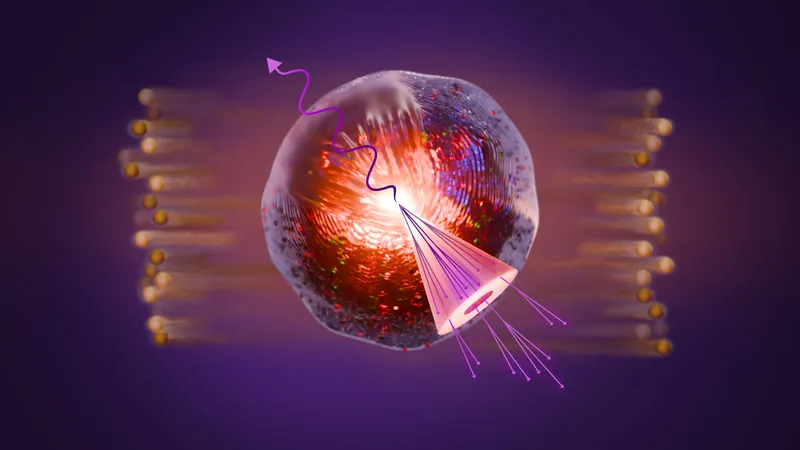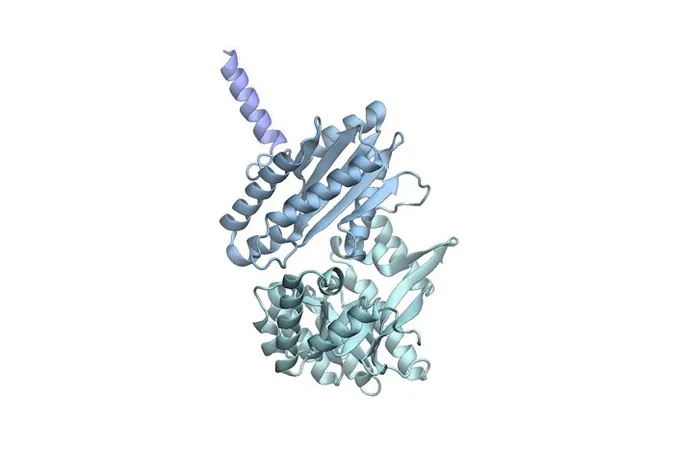
Incredible Discovery: Quark-Gluon Plasma 'Splash' Revealed in High-Energy Collisions!
2025-06-11
Author: Wei Ling
What Happens When Matter Unfolds?
Exciting revelations from the Relativistic Heavy Ion Collider (RHIC) at Brookhaven National Laboratory are transforming our understanding of the universe's earliest moments. New measurements indicate that when energetic particles collide, they induce a fascinating ‘splash’ of quark-gluon plasma (QGP), the primordial state of matter that existed just after the Big Bang.
A Peek into the Primordial Soup
Recent findings, detailed in two groundbreaking papers, highlight the interaction between high-energy particle jets and the QGP produced by these collisions. This research allows scientists to scrutinize how the plasma behaves in response to various energetic jets, offering fresh insights into its extraordinary characteristics. "Instead of just observing what happens to the jet, we want to understand what it reveals about the QGP itself," explained physicist Peter Jacobs of the STAR Collaboration.
Recreating the Big Bang
Scientists recreate the conditions of the early universe by smashing gold nuclei at nearly the speed of light. These collisions generate QGP, enabling researchers to study the basic constituents of matter—quarks and gluons. However, capturing this fleeting phenomenon is a monumental challenge, lasting only a trillionth of a trillionth of a second.
Harnessing Energy from the Splash
Unlike traditional methods of study, where scientists might use microscopes, the QGP's quick existence pushes researchers to innovate. The jets emerging from these collisions act like X-ray beams, revealing crucial information about the plasma. The latest study employed newly refined techniques to identify photon-correlated jets that provide deeper insight into the QGP's behavior.
Discovering Jet Quenching
Traditionally, scientists focused on the phenomenon of jet quenching, where energetic jets lose energy as they interact with the QGP. Recent advancements, however, allow researchers to reconstruct deeper correlations between the jet particles and the QGP, offering a richer understanding of how energy is dispersed.
Breaking New Ground: Photons as Indicators
The research broke new ground by incorporating photon analysis in conjunction with jet reconstruction. Photons, which don’t interact with QGP, serve as a benchmark for analyzing jet energies. This innovative approach allowed scientists to distinguish direct photons produced during collisions, leading to a more nuanced understanding of the energetic jets.
Splashing Energy Across Space!
The results of the research indicate that as jets traverse the QGP, the energy is redistributed—akin to water splashing sideways when you hit a puddle. When examining collisions between gold nuclei, a broader distribution of energy reflected how the QGP absorbed some of the jet’s energy.
Implications for Understanding the Quantum World!
The study hints at important conclusions about the QGP’s viscosity, suggesting it acts almost like a perfect fluid with near-frictionless flow. Future inquiries will focus on how energy loss changes with the length of a jet's path through the plasma and the nature of its interactions.
Conclusion: A Polymer of Questions!
This promising research not only opens doors to new questions but also propels our understanding of the universe's origins. The collaboration across various scientific teams indicates a collective desire to decode the mysteries of QGP and its role in shaping everything around us. As researchers dive deeper into this enigmatic state of matter, we can expect even more astonishing discoveries about the fabric of the cosmos!




 Brasil (PT)
Brasil (PT)
 Canada (EN)
Canada (EN)
 Chile (ES)
Chile (ES)
 Česko (CS)
Česko (CS)
 대한민국 (KO)
대한민국 (KO)
 España (ES)
España (ES)
 France (FR)
France (FR)
 Hong Kong (EN)
Hong Kong (EN)
 Italia (IT)
Italia (IT)
 日本 (JA)
日本 (JA)
 Magyarország (HU)
Magyarország (HU)
 Norge (NO)
Norge (NO)
 Polska (PL)
Polska (PL)
 Schweiz (DE)
Schweiz (DE)
 Singapore (EN)
Singapore (EN)
 Sverige (SV)
Sverige (SV)
 Suomi (FI)
Suomi (FI)
 Türkiye (TR)
Türkiye (TR)
 الإمارات العربية المتحدة (AR)
الإمارات العربية المتحدة (AR)